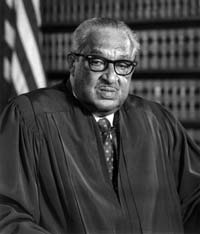
| Born: July 2nd, 1908 in Baltimore, Maryland |
| Died: January 24th, 1993 (at age 84) in Bethesda, Maryland |
| Fields: Law, Politics |
| Famous For: First African American Supreme Court Justice |
| Awards: Spingarn Medal, U.S. Senator John Heinz Award, Liberty Medal, Presidential Medal of Freeom |
Thurgood Marshall’s birth name was actually Thoroughgood, but because he did not like spelling it he shortened it in second grade to the current spelling. His parents instilled in him an appreciation for the constitution and a respect for the law of the land. He was a descendant of two generations of slaves with both his grandfather and great grandfather having both been slaves.
In 1925 Thurgood Marshall graduated from the F. Douglas high school in Baltimore Maryland a year earlier than expected with a solid B average. He placed in the top third of his class. Marshall applied to attend Lincoln University and study Law as he aspired to become a lawyer. In the beginning Mr. Marshall did not take his university classes seriously and after hazing and performing pranks on fellow students was twice suspended for said inappropriate and unacceptable behavior. His political activity at first was not too terribly important to him but later he would become a star student in the debate team during his freshman year.
During his second year at the university he was elected a member of the first black fraternity Alpha Phi Alpha. It was not until the fall of 1929 that he married Vivien Burey and began to crack down on his studies receiving his degree cum laude from Lincoln.
Thurgood Marshall strongly desired to return to his hometown of Maryland to study at the University of Maryland Law School, but due to their segregation policy he thought better of it. Instead he enrolled in the school of law at Howard University. While attending Howard, Marshall studied his hardest. This was where his views on discrimination were greatly influenced by the University’s Dean, Mr. Houston. Marshall’s study convictions netted him his degree in Law in 1933 where he graduated at the top of his class. In 1936, Thurgood Marshall successfully represented his client in a lawsuit against Maryland University, putting a long overdue end to the Universities segregation policy.
Marshall’s wife Vivien passed away in 1955 for an unknown reason. From the union of his second wife, Cecilia Suyat, the couple had two sons. One of their sons Thurgood Marshall Jr. was a former top aide to President Bill Clinton while their son John W. Marshall was a former U.S. Marshals service director and Virginia Public Safety secretary. Marshall and Cecilia were married until his passing in 1993.
In 1936, Thurgood Marshall set up his private practice in Baltimore and began working with the NAACP and won his first case; Murry vs. Peterson. In this case his client, a college graduate with outstanding credentials, was denied admission to the Maryland School of Law because of their segregation policy. The successful outcome of the lawsuit ended the University’s segregation rules. While it was a monumental victory, the State Court’s ruling encompassed only the state of Maryland. At age 32, Marshall won his first U.S. Supreme Court Case of Chambers vs. Florida. He was also appointed Chief Advisor for the National Advancement for All Colored People. Thurgood Marshall continued to argue numerous other civil rights cases, most of which were successful, including; Smith vs. Allwright and others. Yet, his most notable case as a Lawyer was Brown vs. Board of Education. In this case, the Supreme Court ruled that the legal doctrine in the U.S. Constitution which justifies the separation of people based on race in their daily lives did not apply to public education because such separation could never be equal.
In 1961 President JFK appointed Marshall to the U.S. Court of Appeals in the second circuit and in 1967 President Johnson selected Marshall to the Supreme Court. Thurgood Marshall served on the Supreme Court for almost two and a half decades.